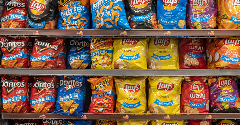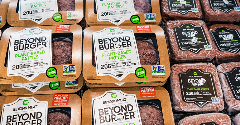News
Natural solutions for salt reduction
5 Apr 2018Salt reduction is one of the food industry’s megatrends, but many of the options available to food manufacturers clash with demand for clean labels.

Food manufacturers have been under pressure to cut salt in their products, as up to 80% of salt intake comes from processed foods. While salt is a vital nutrient, most people consume far more than the World Health Organization’s recommended five gram daily maximum to control blood pressure, with average intakes of 10-12 grams across Western Europe.
One of the most common approaches to salt reduction has been replacing some of the ordinary salt (sodium chloride) in a product with potassium chloride, but suppliers say the ingredient’s chemical-sounding name may be off-putting for consumers. Supplier NuTek Food Science has even filed a petition with the U.S. Food and Drug Administration asking it to allow companies to use the term ‘potassium salt’ on ingredient lists. NuTek Food Science uses label-friendly carriers for its potassium chloride, such as rice flour and wheat flour, which also help tackle its metallic aftertaste. The company suggests that calling it ‘potassium salt’ would help demystify the ingredient for consumers. In addition, it could encourage more companies to reduce sodium in their foods.Clean label salt replacementHowever, potassium chloride is far from the only game in town, and many ingredient suppliers have innovated to cut salt in ways that keep labels consumer-friendly. Israeli company Salt of the Earth, for example, is primarily a salt supplier, but it has embraced the salt reduction trend. Among its products is a microsalt that dissolves more quickly on the tongue than ordinary salt, which allows companies to use less while producing the same perception of saltiness. Recently, it has also developed a product called Mediterranean Umami, which combines sea salt with umami-rich ingredients like tomato concentrate, mushroom and seaweed extracts to play up hearty, savoury tastes in condiments, soups and sauces while cutting salt.Tate & Lyle has gone a slightly different ‘micro’ route with its Soda-Lo Salt Microspheres. These are free-flowing spheres made of salt, so they taste like salt and, crucially, can be labelled as salt. They are smaller than regular salt crystals, and also are hollow, which maximises their surface area relative to their volume, thereby delivering the same salty flavour with up to 50% less salt.Researchers have also found potential in other approaches including uneven dispersal of salt crystals in bread and cereals to enhance salty taste perception, or encapsulating small salt particles to slow flavour release.Another interesting solution comes from Swedish firm Salinity. Its Saltwell product comes from an underwater reservoir in the Chilean Atacama Desert, where the brine produces salt that is naturally rich in potassium chloride. Evaporated by wind and sun, the resulting product can be labelled as ‘sea salt’ but contains just 65% sodium chloride, and 35% potassium chloride. The company claims that the naturally occurring potassium lacks the metallic aftertaste associated with other potassium chloride-based salt replacers on the market.Overcoming negative connotations around salt reductionClean label is one thing, but being able to reduce salt without adding to the ingredient list at all could be advantageous. While companies have been exploring different salt reduction strategies, many have been reluctant to tell consumers that they are reducing the salt in their products, fearing that some people will equate ‘less salt’ with ‘less flavour’. Looking beyond the ingredients themselves, gradually reducing salt levels without using any salt replacers is another natural approach that many companies have taken. It works to shift consumer tastes for salt across a population, and is most effective when the whole food industry – or at least a whole food category – is moving at a similar pace, which may happen when companies are encouraged to meet incremental targets.This approach can have significant success. In the UK, where the government set voluntary targets in 2006, salt levels in breakfast cereals fell nearly 50% from 2004 to 2015 and average salt consumption declined about 11%.Related news

PepsiCo formulates ‘naked’ Cheetos and Doritos products
31 Dec 2025
US food giant PepsiCo has launched its Simply NKD range, a move it says reimagines its popular products with new formulations free from artificial flavours, dyes, and colours.
Read more
Debate over ban on ‘meaty’ names for plant-based products reaches stalemate
26 Dec 2025
The debate over a ban on plant-based products using “meaty” terms has reached a stalemate, leaving manufacturers in limbo and still facing overhauls to their marketing and packaging.
Read more
Has ‘clean’ had its day?
22 Dec 2025
Wielding clean-label positioning and fortification as marketing levers is a dangerous strategy, and brands would be better off explaining the hows and whys of the ingredients in their products, say experts.
Read more
Bigging up bean-based products and consumption in Britain
19 Dec 2025
Non-profit organisation the Food Foundation has launched a campaign, “Bang in Some Beans”, designed to increase UK consumers’ legume consumption.
Read more
Ingredient transparency key to success in European natural health market
12 Dec 2025
Europe’s $40.7 billion supplements market is growing fast, fuelled by demand for products that support healthy ageing, mental wellbeing, and preventive health, say experts.
Read more
Sorghum emerges as better-for-you hero ingredient
9 Dec 2025
With the launch of Novak Djokovic’s sorghum-based brand, the grain’s popularity in the better-for-you snacking sphere is on the rise, thanks to its nutritional and sensory properties.
Read more
Innovation promise in 'maturing' plant-based dairy alternatives market
8 Dec 2025
Plant-based dairy is a maturing market that still faces significant hurdles around taste, functionality, nutrition, and price, but industry is innovating fast, according to experts speaking at Fi Europe.
Read more
Celebrating the winners of the Fi Europe Innovation Awards 2025
3 Dec 2025
Food industry stakeholders celebrated as the winners of the Fi Europe Innovation Awards were announced at a ceremony in Paris.
Read more
Yuka’s food scanning app helps consumers make healthier choices
2 Dec 2025
Global food scanning app Yuka helps consumers understand the content of their shopping baskets and shapes producers’ reformulation plans.
Read more
Non-UPF Program extends certification scheme to entire food industry
30 Nov 2025
The Non-UPF Program has extended its certification scheme to the wider food sector, championing a move towards healthier consumption habits.
Read more
